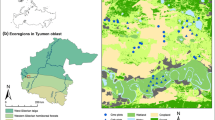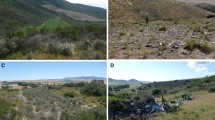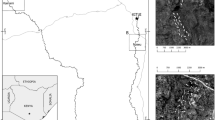Abstract
Habitat loss and fragmentation are known to reduce patch sizes and increase their isolation, consequently leading to modifications in species richness and community structure. Calcareous grasslands are among the richest ecosystems in Europe for insect species. About 10% (1,150 ha) of the total area of a calcareous ridge region (Calestienne, Belgium) and its butterfly community was analysed over a timeframe of about 100 years. Since 1905 to present day (2005), the Calestienne region has undergone both calcareous grassland loss and fragmentation: not only did calcareous grassland size decrease and isolation increase, but also, the number of calcareous grassland patches within the landscape increased until 1965, and subsequently decreased, clearly reflecting the effects of fragmentation. These processes have had a profound effect on the butterfly community: extinction and rarefaction affected significantly more often specialist species, which means that generalist species are more and more overrepresented. This ecological drift, i.e. the replacement of specialists by generalists in species assemblages is likely to be a general effect of habitat loss and fragmentation on natural communities.
Similar content being viewed by others
References
Akaike H (1978) A Bayesian analysis of the minimum AIC procedure. Ann Inst Stat Math 30:9–14
Andrén H (1994) Effects of habitat fragmentation on birds and mammals in landscapes with different proportions of suitable habitat: a review. Oikos 71:355–366
Andrén H (1996) Population responses to habitat fragmentation: statistical power and the random sample hypothesis. Oikos 76:235–242
Andre´n H (1999) Habitat pragmentation, the random sample hyopthesis and critical thresholds. Oikos 84(2): 306–308.
Austrheim G, Gunilla E, Olsson A, Grontvedt E (1999) Land-use impact on plant communities in semi-natural sub-alpine grasslands of Budalen, central Norway. Biol Conserv 87:369–379
Baguette M, Mennechez G (2004) Resource and habitat patches, landscape ecology and metapopulation biology: a consensual viewpoint. Oikos 106:399–403
Baguette M, Petit S, Quéva F (2000) Population spatial structure and migration of three butterfly species within the same habitat network: consequences for conservation. J Appl Ecol 37:100–108
Baguette M, Mennechez G, Petit S, Schtickzelle N (2003) Effect of habitat fragmentation on dispersal in the butterfly Proclossiana eunomia. Comp Ren Biol 326:S200–S209
Balmer O, Erhardt A (2000) Consequences of succession on extensively grazed grasslands for central European butterfly communities: Rethinking conservation practices. Conserv Biol 14:746–757
Bourn NAD, Thomas JA (2002) The challenge of conserving grassland insects at the margins of their range in Europe. Biol Conserv 104:285–292
Bruynseels G, Vermander J (1984) L’évolution de la végétation calcicole de Nismes à Vaucelles. Parcs Nationaux Ardenne et Gaume 34:71–80
Cousins SAO, Eriksson O (2001) Plant species occurrences in a rural hemiboreal landscape: effects of remnant habitats, site history, topography and soil. Ecography 24:461–469
Erhardt A, Thomas JA (1991) Lepidoptera as indicators of change in the semi-natural grasslands of lowland and upland Europe. In: Collins NM (eds) The conservation of insects and their habitats. Academic press, London
Fahrig L (1997) Relative effects of habitat loss and fragmentation on population extinction. J Wildlife Manage 61:603–610
Fahrig L, Merriam G (1984) Conservation of fragmented populations. Conserv Biol 8:50–59
Fontaine M, Leestmans R, Duvigneaud J (1983) Les Lépidoptères de la partie méridionale de l’Entre-Sambre-et-Meuse et de la pointe de Givet. Linn Belg 9:3–62
Forman RTT (1995) Land mosaics: the ecology of landscapes and regions. Press Syndicate of the University of Cambridge, Cambridge
Foster DR, Boose ER (1992) Patterns of forest damage resulting from catastrophic wind in Central New-England, USA. J Ecol 80:79–98
Goffart Ph, Baguette M, De Bast B (1992) La situation des Lépidoptères Rhopalocères en Wallonie ou Que sont nos papillons devenus? Bull Ann Soc r belg d’Entomol 128:355–392
Goffart Ph, De Bast B (2000) Atlas préliminaire des papillons de jour de Wallonie et liste rouge révisée. Groupe de Travail Lépidoptères, Marche
Hanski I (1999) Habitat connectivity, habitat continuity, and metapopulations in dynamic landscapes. Oikos 87:209–219
Harrison S, Bruna E (1999) Habitat fragmentation and large-scale conservation: what do we know for sure? Ecography 22:225–232
Huxel GR, Hastings A (1999) Habitat loss, fragmentation, and restoration. Restor Ecol 7:309–315
Jenness J (2003) Identify Features Within Distance, v. 1.b (id_within_dist.avx) Extension for ArcView 3.x. Jenness Enterprises. Available at: http://www.jennessent.com/arcview/within_distance.htm
Krauss J, Steffan-Dewenter I, Tscharntke T (2003) How does landscape context contribute to effects of habitat fragmentation on diversity and population density of butterflies? J Biogeogr 30:889–900
Kruess A, Tscharntke T (1994) Habitat fragmentation, species loss, and biological control. Science 264:1581–1584
Kruess A, Tscharntke T (2000) Species richness and parasitism in a fragmented landscape: experiments and field studies with insects on Vicia sepium. Oecologia 122:129–137
Kudrna O (1986) Aspects of the conservation of butterflies in Europe. AULA Verlag, Wiesbaden
Lafranchis T (2000) Les papillons de jour de France, Belgique et Luxembourg et leurs chenilles. Parthénope, Mèze
Lambillion L-J (1903) Catalogue des Lépidoptères de Belgique. Société Entomologique de Namur, Namur
Lameere A (1940) Les animaux de la Belgique, Tome III. Les Naturalistes Belges, Bruxelles
Lhomme L (1923) Catalogue des Lépidoptères de France et de Belgique, Volume I. Léon Lhomme, Paris
Maes D, Van Dyck H (2001) Butterfly diversity loss in Flanders (north Belgium): Europe’s worst case scenario? Biol Conserv 99:263–276
Mennechez G, Schtickzelle N, Baguette M (2003) Metapopulation dynamics of the bog fritillary butterfly: comparison of demographic parameters and dispersal between a continuous and a highly fragmented landscape. Landscape Ecol 18:279–291
Moilanen A, Nieminen M (2002) Simple connectivity measures in spatial ecology. Ecology 83:1131–1145
New TR (1997) Are Lepidoptera an effective ‘umbrella group’ for biodiversity conservation? J Insect Conserv 1:5–12
Saunders DA, Hobbs RJ, Margules CR (1991) Biological consequences of ecosystem fragmentation – a review. Conserv Biol 5:18–32
Steffan-Dewenter I, Tscharntke T (1999) Effects of habitat isolation on pollinator communities and seed set. Oecologia 121:432–440
Steffan-Dewenter I, Tscharntke T (2000) Butterfly community structure in fragmented habitats. Ecol Lett 3:449–456
Steffan-Dewenter I, Tscharntke T (2002) Insect communities and biotic interactions on fragmented calcareous grasslands – a mini review. Biol Conserv 104:275–284
Thomas JA (1991) Rare species conservation: case studies of European butterflies. In: Spellerberg I, Goldsmith F, Morris M (eds) The scientific management of temperate communities for conservation. Blackwell Scientific Publications, Oxford, pp 149–197
Tilman D, May RM, Lehman CL, Nowak MA (1994) Habitat destruction and the extinction debt. Nature 371:65–66
Tscharntke T, Steffan-Dewenter I, Kruess A, Thies C (2002a) Characteristics of insect populations on habitat fragments: a mini review. Ecol Res 17:229–239
Tscharntke T, Steffan-Dewenter I, Kruess A, Thies C (2002b) Contribution of small habitat fragments to conservation of insect communities of grassland-cropland landscapes. Ecol Appl 12:354–363
Van Schepdael J (1963) Nismes ou le bonheur de l’entomologiste. Parcs Nationaux Ardenne et Gaume 18:51–55
van Swaay CAM (2002) The importance of calcareous grasslands for butterflies in Europe. Biol Conserv 104:315–318
Wallis De Vries MF, Poschlod P, Willems JH (2002) Challenges for the conservation of calcareous grasslands in northwestern Europe: integrating the requirements of flora and fauna. Biol Conserv 104:265–273
Wilcox BA, Murphy DD (1985) Conservation strategy: the effects of fragmentation on extinction. Am Nat 125:879–887
Acknowledgements
We warmly thank Jan Bultaye and Olivier Honnay for their ongoing support in the frame of the BIOCORE project aiming at defragmenting calcareous grasslands in the Viroin valley. Olivier Honnay kindly commented a first draft of the paper. This work was funded by grants from the Belgian Science Policy Office to MB (contracts BELSPO-PADD II EV10/26A, 2003–2006 and PADD II support action 2005–2007). Special capture licences were provided by the Ministère de la Région Wallonne, Division Nature et Forêt (Dir. Ph. Blerot). Site access was granted by the Ministère de la Région Wallonne and nature conservation associations (Cercle des Naturalistes de Belgique, Natagora). This is publication BRC-088 of the Biodiversity Research Centre.
Author information
Authors and Affiliations
Corresponding author
Rights and permissions
About this article
Cite this article
Polus, E., Vandewoestijne, S., Choutt, J. et al. Tracking the effects of one century of habitat loss and fragmentation on calcareous grassland butterfly communities. Biodivers Conserv 16, 3423–3436 (2007). https://doi.org/10.1007/s10531-006-9008-y
Received:
Accepted:
Published:
Issue Date:
DOI: https://doi.org/10.1007/s10531-006-9008-y




